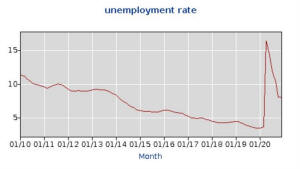Extended federal benefits end for some jobless residents
 Send a link to a friend
Send a link to a friend
[March 05, 2021]
By SARAH MANSUR
Capitol News Illinois
smansur@capitolnewsillinois.com
 SPRINGFIELD — Benefits for some unemployed
state residents provided under an aid program targeting mostly
self-employed and gig workers will be capped at 50 weeks instead of 57,
the state announced Wednesday. SPRINGFIELD — Benefits for some unemployed
state residents provided under an aid program targeting mostly
self-employed and gig workers will be capped at 50 weeks instead of 57,
the state announced Wednesday.
The shortened period for benefits under the Pandemic Unemployment
Assistance program was triggered by a decline in the state’s
unemployment rate.
The PUA program, which was first established by Congress last March,
offers benefits to independent contractors, self-employed individuals,
gig workers and others not covered by traditional state unemployment
insurance.

After Congress renewed the program in December, eligible individuals
could receive up to 57 weeks of PUA benefits. The law passed in
December, the Continued Assistance Act, also extended regular state
unemployment insurance benefits by seven weeks.
Both those seven-week benefit extensions have ended, according to a
state news release. This means individuals eligible for PUA will receive
up to 50 weeks of benefits, and those eligible for extended regular
state unemployment insurance benefits will receive up to 13 weeks of
benefits.
Roughly 40,000 individuals have been notified that they have exhausted
their 50 weeks of PUA, according to Rebecca Cisco, a spokesperson for
the Illinois Department of Employment Security.
“IDES will continue to notify PUA claimants as they approach the 50 week
limit. And, of course, the Department is closely monitoring activity at
the federal level in the event new legislation includes extensions or
changes to the PUA program,” Cisco wrote in an email.
Individuals who qualify for PUA but have not yet received some of their
benefits will only be eligible for benefits through April 10, Acting
IDES Director Kristin Richards said in response to a question during a
virtual joint committee hearing Wednesday.
[to top of second column]
|

A U.S. Bureau of Labor Statistics graphic shows the
state's unemployment rate from 2010 to the end of 2020. The state
reported Tuesday that Pandemic Unemployment Assistance benefits have
ended due to a decline in the state’s unemployment rate. (Credit:
U.S. Bureau of Labor Statistics)

Richards said the U.S. Department of Labor’s Bureau of Labor
Statistics determined that the average unemployment rate for
October, November and December fell below 8 percent.
“The federal government made a determination based on unemployment
data from the state of Illinois, over a three-month average,”
Richards said. “They evaluate all this data and arrive at a
conclusion. And that conclusion was that we were triggering off this
high unemployment period.”
Under federal law, states are only able to access two seven-week
extensions if the state is in a so-called “high unemployment
period.” An IDES spokesperson did not immediately respond to an
email seeking clarification on what constituted a high unemployment
period.
The not seasonally adjusted unemployment rates in Illinois for
October, November, and December were 7.5 percent, 7.6 percent and
7.9 percent, respectively, according to Department of Labor data.
The state’s seasonally adjusted unemployment rates for October,
November, and December were 8.1 percent, 8.1 percent and 8 percent,
respectively.
Capitol News Illinois is a nonprofit, nonpartisan
news service covering state government and distributed to more than
400 newspapers statewide. It is funded primarily by the Illinois
Press Foundation and the Robert R. McCormick Foundation.
 |